Change Language :
iglide® W300 - Material data
Previously named iglide® L280
| General features | Unit | iglide W300 | Test method |
|---|---|---|---|
| Density | g/cm³ | 1.24 | |
| Color | Yellow | ||
| Max. humidity absorption at 73° F/50% R. H. | Wt.-% | 6.5 | |
| Coefficient of surface friction, dynamic, against steel | µ | 0.08 - 0.23 | |
| p x v value, max. (dry) | psi x fpm | 6,600 | |
| Mechanical properties | |||
| Modulus of elasticity | psi | 507,600 | DIN 53457 |
| Tensile strength at 68° F | psi | 18,130 | DIN 53452 |
| Compressive strength | psi | 8,847 | |
| Permissible static surface pressure (68° F) | psi | 8,702 | |
| Shore D hardness | 77 | DIN 53505 | |
| Physical and thermal properties | |||
| Max. long-term application temperature | °F | 194 | |
| Max. short-term application temperature | °F | 356 | |
| Min. application temperature | °F | -40 | |
| Thermal conductivity | [W/m x K] | 0.24 | ASTM C 177 |
| Coefficient of thermal expansion | [K-1 x 10-5 ] | 9 | DIN 53752 |
| Electrical properties | |||
| Specific volume resistance | Ωcm | > 1013 | DIN IEC 93 |
| Surface resistance | Ω | > 1012 | DIN 53482 |
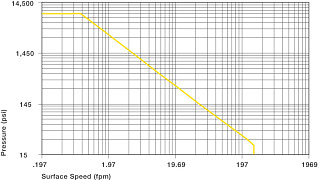
Permitted p x v values
For iglide® W300 plastic bushings with 0.03937 (1 mm) wall thickness in dry operation against a steel shaft, at 68° F, installed in a steel housing.
High wear resistance, particularly in environments with abrasive media or in connection with coarse shafts, distinguishes the iglide® W300 material. Among all iglide® materials, this is the most insensitive to such external influences.
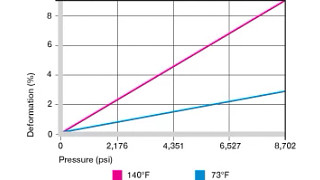
Figure 5.2: Deformation under load and temperatures
Compressive Strength
iglide® W300 shows a very high compressive strength despite high elasticity. Figure 5.2 shows the elastic deformation of iglide® W300 with radial loads. Under the maximum recommended surface pressure of 8700 psi, the deformation at room temperature amounts to less than 3%.
A plastic deformation at room temperature is practically negligent within the maximum recommended surface pressure of 8700 psi.
Permitted surface speeds
Even at higher surface speeds, the coefficients of friction of iglide® W300 plastic bushings do not increase. Therefore compared to other materials it can attain slightly higher surface speeds, for instance up to 295 fpm rotating and up to 984 fpm linear.
Due to the extraordinary wear resistance, the bushing wear remains low also in long-term application with high speeds.
Extremely high speeds can be attained with iglide® W300 plastic bushings on hardened, not too smooth shafts.
| Maximum surface speed | |||
|---|---|---|---|
| fpm | Rotating | Oscillating | Linear |
| Continuous | 196 | 137 | 787 |
| Short-term | 492 | 354 | 1181 |
Temperatures
iglide® W300 plastic bushings are extremely insensitive to alternating external influences. This applies also to temperatures. iglide® W300 plastic bushings retain their extraordinary abrasion resistance even up to the maximum permitted application temperatures and do not tend to become brittle at low temperatures.
In contrast the mechanical properties limit the usability of iglide® W300 at high temperatures. A relaxation of the bushings can occur at temperatures of 176° F. In the process the bushing's press-fit force can reduce so strongly that with re-cooling and the entailing shrinking, the bushing can creep out.
In order to prevent this, in applications from 140° F the iglide® W300 plastic bushings should be certainly mechanically secured in addition.
| Temperature limits | |
|---|---|
| iglide® W300 | Application temperature |
| Lower | - 40 °F |
| Upper, long-term | + 194 °F |
| Mechanically secured | + 266 °F |
| Upper, short-term | + 356 °F |
| Additional axial securing | + 140 °F |
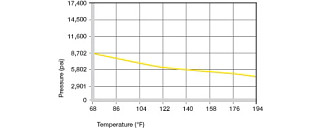
Figure 5.3: Maximum recommended surface pressure dependent on the temperature
Figure 5.3: Maximum recommended surface pressure dependent on the temperature
Friction and wear
The coefficients of surface friction of the iglide® W300 decreases with increasing load. In dry operation paired with steel (Cold Rolled Steel), they reduce by about 25% just in the load range of p = 72.5 to 507.5 psi.
In contrast to other iglide® materials, the coefficient of friction of the iglide® W300 remains constantly low even at higher peripheral speeds.
Friction and wear also depend to a high degree on the reverse partner. Very smooth shafts increase the coefficient of both friction and wear. Smooth shafts entail the danger of stick-slip. The squeaking noise as an effect of stick-slip is often the result of extremely smooth shafts. Please note that a smoothing of the shaft surface can also occur due to the operation.
For minimum coefficients of friction with iglide® W300 plastic bushings, the shaft surface should not be too smooth. Shaft surface finish of 16 to 20 rms are the ideal (see Fig. 5.6) For the iglide® W300, the wear resistance is still excellent with this surface finish as the friction adopt the minimum value.
| Coefficients of friction for iglide® W300 against steel (shaft finish = 40 rms, 50 HRC) | ||||
|---|---|---|---|---|
| iglide® W300 | Dry | Grease | Oil | Water |
| Coefficients of friction µ | 0.08 - 0.23 | 0.09 | 0.04 | 0.04 |

Figure 5.4: Coefficients of friction dependent on the surface speed, p = 108 psi, shaft made of Cold Rolled Steel
Figure 5.4: Coefficients of friction dependent on the surface speed, p = 108 psi, shaft made of Cold Rolled Steel
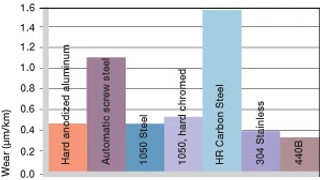
Fig. 2.7: Wear, rotating application with different shaft materials, load p = 108 psi
Shaft materials
The diagrams display a summary of the results of tests with different shaft materials conducted with bushings made of iglide® W300.
In rotating applications the wear shows variations indeed according to the shaft at low loads, but the iglide® W300 displays excellent to acceptable coefficients of wear with all tested shafts. iglide® W300 like hard shafts. The iglide® W300 is the most suitable iglide® material at low radial loads and with hard-chromed shafts and hard shafts made of corrosion-resistant steel (X90). The soft shaft materials ST37 and machining steel are not as suitable for the iglide® W300 bushings.
At high loads, hardened shafts should be chosen. Diagram 5.8 clearly shows the differences with rising loads. A similar picture emerges in pivoting applications. With initial low loads, the wear for the pivoting motion lies actually lower than that for a rotation at the same load. This picture changes with higher loads.
Please contact us in case the shaft material scheduled by you is not included in this list of tested glide partners.
Friction and wear
The coefficients of surface friction of the iglide® W300 decreases with increasing load. In dry operation paired with steel (Cold Rolled Steel), they reduce by about 25% just in the load range of p = 72.5 to 507.5 psi.
In contrast to other iglide® materials, the coefficient of friction of the iglide® W300 remains constantly low even at higher peripheral speeds.
Friction and wear also depend to a high degree on the reverse partner. Very smooth shafts increase the coefficient of both friction and wear. Smooth shafts entail the danger of stick-slip. The squeaking noise as an effect of stick-slip is often the result of extremely smooth shafts. Please note that a smoothing of the shaft surface can also occur due to the operation.
For minimum coefficients of friction with iglide® W300 plastic bushings, the shaft surface should not be too smooth. Shaft surface finish of 16 to 20 rms are the ideal (see Fig. 5.6) For the iglide® W300, the wear resistance is still excellent with this surface finish as the friction adopt the minimum value.
| Coefficients of friction for iglide® L280 against steel (Shaft finish = 40 rms, 50 HRC) | ||||
|---|---|---|---|---|
| iglide® L280 | Dry | Grease | Oil | Water |
| Coefficients of friction µ | 0.08 - 0.23 | 0.09 | 0.04 | 0.04 |
Installation tolerances
iglide® W300 plastic bushings are standard bushings for shafts with h-tolerance (recommended minimum h9). After the installation in a housing bore with the H7 tolerance, the inner diameter of the bushing automatically adjusts to the E10 tolerance.
| Important tolerances for iglide® L280 plastic bushings according to ISO 3547-1 after the press-fit. | ||
|---|---|---|
| Diameter D1 [inches] | Shaft h9 [inches] | iglide® W300 E10 [inches] |
| Up to 0.0197 | 0 - 0.000984 | +0.0005512 + 0.0021260 |
| > 0.1181 to 0.2362 | 0 - 0.001181 | +0.0007874 + 0.0026772 |
| > 0.2362 to 0.3937 | 0 - 0.001417 | +0.0009842 + 0.0032677 |
| > 0.3937 to 0.7087 | 0 - 0.001693 | +0.0012598 + 0.0040157 |
| > 0.7087 to 1.1811 | 0 - 0.002047 | +0.0015748 + 0.0048819 |
| > 1.1811 to 1.9685 | 0 - 0.002441 | +0.0019685 + 0.0059055 |
| > 1.9685 to 3.1496 | 0 - 0.002913 | +0.0023622 + 0.0070866 |
| > 3.1496 to 4.7244 | 0 - 0.003425 | +0.0028346 + 0.0083464 |
| > 4.7244 | 0 - 0.003937 | +0.0033464 + 0.0096456 |
Chemical resistance
iglide® W300 plastic bushings have a good resistance against chemicals. They are resistant to most lubricants. iglide® W300 is not affected by most weak organic and inorganic acids.
The humidity absorption of iglide® W300 plastic bushings amounts to about 1.3 Wt.-% in standard climatic conditions. The saturation limit in water is 6.5%. This should be considered according to environmental influences.
Table Legend
+ resistant
0 conditionally resistant
- non-resistant
| Medium | Resistance |
|---|---|
| Alcohol | + to 0 |
| Hydrocarbons, chlorinated | - |
| Greases, oils without additives | - |
| Fuels | - |
| Diluted acids | 0 to - |
| Strong acids | - |
| Diluted bases | - |
| Strong bases | 0 |
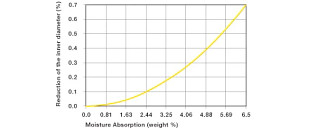
Figure 5.10: Influence of moisture absorption of iglide® L280 bushings
Radioactive rays
iglide® W300 plastic bushings are radiation resistant up to a radioactive intensity of 3 x 10² Gy.
UV-resistant
iglide® W300 plastic bushings are permanently resistant against UV rays. A minor variation in the color (dark) through UV radiation and other atmospheric exposures influences the mechanical, electrical or thermal properties only insignificantly.
| Specific volume resistance | Surface resistance |
|---|---|
| > 10^13 Ωcm | > 10^12 Ω |
Contact Us
Questions or product information? Please contact:

Customer Service:
Monday to Friday from 8 am - 8 pm
Online:
24h



